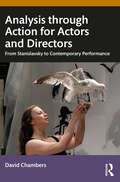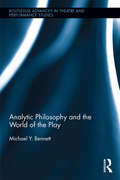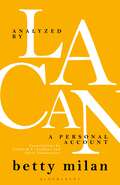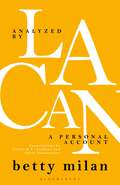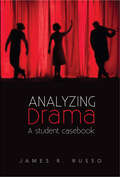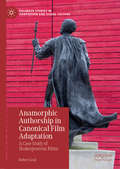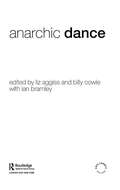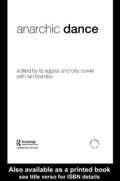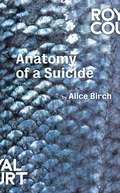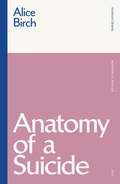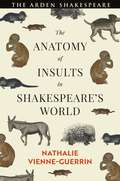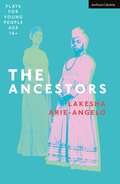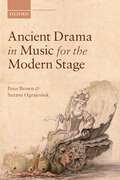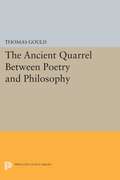- Table View
- List View
Analysing Gender in Performance
by J. Paul Halferty Cathy LeeneyAnalysing Gender in Performance brings together the fields of Gender Studies and Performance Analysis to explore how contemporary performance represents and interrogates gender. This edited collection includes a wide range of scholarly essays, as well as artists’ voices and their accounts of their works and practices. The Introduction outlines the book’s key approaches to concepts in English language gender discourses and gender’s intersectionalities, and sets out the approaches to performance analysis and methods of research employed by the various contributors. The book focuses on performances from the Global North, staged over the past fifty years. Case studies are diverse, ranging from site-specific, dance theatre, speculative drag, installation, and music video performances to Mabou Mines, Churchill, Shakespeare and Ibsen. Contributors explore how gender intersects with sexuality, social class, race, ethnicity, indigeneity, culture and history. Read individually or in tension with one another, the essays confront the contemporary complexities of analysing gender in performance.
The Analysis of Performance Art: A Guide to its Theory and Practice
by Anthony Howell A. HowellThis finely illustrated book offers a simple yet comprehensive 'grammar' of a new discipline. Performance Art first became popular in the fifties when artists began creating 'happenings'. Since then the artist as a performer has challenged many of the accepted rules of the theatre and radically altered our notion of what constitutes visual art. This is the first publication to outline the essential characteristics of the field and to put forward a method for teaching the subject as a discipline distinct from dance, drama, painting or sculpture.Taking the theory of primary and secondary colours as his model, Anthony Howell posits three primaries of action and shows how these may be mixed to obtain a secondary range of actions. Based on a taught course, the system is designed for practical use in the studio and is also entertaining to explore. Examples are cited from leading performance groups and practitioners such as Bobbie Baker, Orlan, Stelarc, Annie Sprinkle, Robert Wilson, Goat Island, and Station House Opera. This volume, however, is not just an illustrated grammar of action - it also shows how the syntax of that grammar has psychoanalytic repercussions. This enables the performer to relate the system to lived experience, ensuring a realisation that meaning is being dealt with through these actions and that the stystem set forth is more than a dry structuring of the characteristics of movement.Freud's notion of 'transference' and Lacan's understanding of 'repetition' are compared to a performer's usage of the same terms. Thus the book provides a psychoanalytic critique of performance at the same time as it outlines an efficient method for creating live work on both fine art and theatre courses.
The Analysis of Performance Art: A Guide to its Theory and Practice
by Anthony Howell A. HowellThis finely illustrated book offers a simple yet comprehensive 'grammar' of a new discipline. Performance Art first became popular in the fifties when artists began creating 'happenings'. Since then the artist as a performer has challenged many of the accepted rules of the theatre and radically altered our notion of what constitutes visual art. This is the first publication to outline the essential characteristics of the field and to put forward a method for teaching the subject as a discipline distinct from dance, drama, painting or sculpture.Taking the theory of primary and secondary colours as his model, Anthony Howell posits three primaries of action and shows how these may be mixed to obtain a secondary range of actions. Based on a taught course, the system is designed for practical use in the studio and is also entertaining to explore. Examples are cited from leading performance groups and practitioners such as Bobbie Baker, Orlan, Stelarc, Annie Sprinkle, Robert Wilson, Goat Island, and Station House Opera. This volume, however, is not just an illustrated grammar of action - it also shows how the syntax of that grammar has psychoanalytic repercussions. This enables the performer to relate the system to lived experience, ensuring a realisation that meaning is being dealt with through these actions and that the stystem set forth is more than a dry structuring of the characteristics of movement.Freud's notion of 'transference' and Lacan's understanding of 'repetition' are compared to a performer's usage of the same terms. Thus the book provides a psychoanalytic critique of performance at the same time as it outlines an efficient method for creating live work on both fine art and theatre courses.
Analysis through Action for Actors and Directors: From Stanislavsky to Contemporary Performance
by David ChambersAnalysis through Action for Actors and Directors is a comprehensive view of an innovative and exciting process for making new theatre.As well as an understanding of how Analysis through Action has developed over time, this book also demonstrates how it can be put into practice in today’s theatre. The first part of this book traces the exciting genealogy from Stanislavsky’s unfinished experiments, through the insights of geniuses Maria Knebel and Georgii Tovstonogov, down to today’s avant-garde auteurs. The second part is a practical manual based on extensive field testing by the author and colleagues. Here, two key components of the process are elucidated: Text Actions – ten interwoven text analysis steps – to be twinned with the thrilling rehearsal process using focused and joyful improvisations called Études.Written for new or experienced theatre students and practitioners, this book will enrich the technique of any theatre artist and anyone else interested in the theatre and its future.
Analysis through Action for Actors and Directors: From Stanislavsky to Contemporary Performance
by David ChambersAnalysis through Action for Actors and Directors is a comprehensive view of an innovative and exciting process for making new theatre.As well as an understanding of how Analysis through Action has developed over time, this book also demonstrates how it can be put into practice in today’s theatre. The first part of this book traces the exciting genealogy from Stanislavsky’s unfinished experiments, through the insights of geniuses Maria Knebel and Georgii Tovstonogov, down to today’s avant-garde auteurs. The second part is a practical manual based on extensive field testing by the author and colleagues. Here, two key components of the process are elucidated: Text Actions – ten interwoven text analysis steps – to be twinned with the thrilling rehearsal process using focused and joyful improvisations called Études.Written for new or experienced theatre students and practitioners, this book will enrich the technique of any theatre artist and anyone else interested in the theatre and its future.
Analytic Philosophy and the World of the Play (Routledge Advances in Theatre & Performance Studies)
by Michael Y. BennettTheatrical characters’ dual existence on stage and in text presents a unique, challenging case for the analytical philosopher. Analytic Philosophy and the World of the Play re-examines the ontological status of theatre and its fictional objects through the "possible worlds" thesis, arguing that theatre is not a mirror of our world, but a re-creation of it. Taking a fresh look at theatre’s key elements, including the hotly contested relationships between character and actor; onstage and offstage "worlds"; and the play-text and performance, Michael Y. Bennett presents a radical new way of understanding the world of the play.
Analytic Philosophy and the World of the Play (Routledge Advances in Theatre & Performance Studies)
by Michael Y. BennettTheatrical characters’ dual existence on stage and in text presents a unique, challenging case for the analytical philosopher. Analytic Philosophy and the World of the Play re-examines the ontological status of theatre and its fictional objects through the "possible worlds" thesis, arguing that theatre is not a mirror of our world, but a re-creation of it. Taking a fresh look at theatre’s key elements, including the hotly contested relationships between character and actor; onstage and offstage "worlds"; and the play-text and performance, Michael Y. Bennett presents a radical new way of understanding the world of the play.
Analyzed by Lacan: A Personal Account (Psychoanalytic Horizons)
by Dr. Betty MilanAnalyzed by Lacan brings together the first English translations of Why Lacan, Betty Milan's memoir of her analysis with Lacan in the 1970s, and her play, Goodbye Doctor, inspired by her experience. Why Lacan provides a unique and valuable perspective on how Lacan worked as psychoanalyst as well as his approach to psychoanalytic theory. Milan's testimony shows that Lacan's method of working was based on the idea that the traditional way of interpreting provoked resistance. Prior to Why Lacan, Milan wrote a play, Goodbye Doctor, based on her experience as Lacan's patient. The play is structured around the sessions of Seriema with the Doctor. Through the analysis, Seriema discovers why she cannot give birth, namely, an unconscious desire to satisfy the will of her father who didn't authorize her to conceive. She ceases to be the victim of her unconscious, grasps the possibility of choosing a father for her child and thus becoming a mother. Goodbye Doctor has been adapted into a film, Adieu Lacan, by the director Richard Ledes. Analyzed by Lacan features an Introduction by Milan to both works as well as a new interview with Mari Ruti about her writing and Lacan.
Analyzed by Lacan: A Personal Account (Psychoanalytic Horizons)
by Dr. Betty MilanAnalyzed by Lacan brings together the first English translations of Why Lacan, Betty Milan's memoir of her analysis with Lacan in the 1970s, and her play, Goodbye Doctor, inspired by her experience. Why Lacan provides a unique and valuable perspective on how Lacan worked as psychoanalyst as well as his approach to psychoanalytic theory. Milan's testimony shows that Lacan's method of working was based on the idea that the traditional way of interpreting provoked resistance. Prior to Why Lacan, Milan wrote a play, Goodbye Doctor, based on her experience as Lacan's patient. The play is structured around the sessions of Seriema with the Doctor. Through the analysis, Seriema discovers why she cannot give birth, namely, an unconscious desire to satisfy the will of her father who didn't authorize her to conceive. She ceases to be the victim of her unconscious, grasps the possibility of choosing a father for her child and thus becoming a mother. Goodbye Doctor has been adapted into a film, Adieu Lacan, by the director Richard Ledes. Analyzed by Lacan features an Introduction by Milan to both works as well as a new interview with Mari Ruti about her writing and Lacan.
Analyzing Drama: A Student Casebook
by James R RussoThis play-analysis textbook contains 50 short essays on geographically diverse, historically significant dramas -- among them Major Barbara, Our Town, Hamlet, A Streetcar Named Desire, Romeo and Juliet, Miss Julie, Electra, Death of a Salesman, The Balcony, The Cherry Orchard, Mother Courage, The Merry Wives of Windsor, and Old Times. The essays are supported by a Step-by-Step Approach to Play Analysis, a Glossary of Dramatic Terms, Study Guides, Topics for Writing and Discussion, Bibliographical Resources, and a comprehensive Index. Written for university and advanced high school students, these critical essays provide practical models to aid and promote writing and analytical skills. The author is a close reader committed to a detailed yet objective examination of the structure, style, imagery, and language of a play. He is concerned with dramatic analysis that can be of benefit to directors, designers, and even actors. Analysis of character, action, dialogue, and setting can thus be translated into concepts for theatrical production. The three key benefits of ANALYZING DRAMA are: 1. Most so-called play analysis texts are books about the methods and techniques of play analysis but contain few (if any) actual play analyses. The book describes the methods and techniques of play analysis while at the same time providing numerous examples of such analysis. 2. The Topics for Writing and Discussion and Study Guides provide a wide range of set tasks for students. 3. Readings are not biased by any particular social or political doctrine. Aimed at students, teachers, educated readers, and drama aficionados with an interest in world drama in particular and drama studies in general, as well as at theatregoers with an interest in the practice of play analysis and criticism.
Analyzing Drama: A Student Casebook
by James R RussoThis play-analysis textbook contains 50 short essays on geographically diverse, historically significant dramas -- among them Major Barbara, Our Town, Hamlet, A Streetcar Named Desire, Romeo and Juliet, Miss Julie, Electra, Death of a Salesman, The Balcony, The Cherry Orchard, Mother Courage, The Merry Wives of Windsor, and Old Times. The essays are supported by a Step-by-Step Approach to Play Analysis, a Glossary of Dramatic Terms, Study Guides, Topics for Writing and Discussion, Bibliographical Resources, and a comprehensive Index. Written for university and advanced high school students, these critical essays provide practical models to aid and promote writing and analytical skills. The author is a close reader committed to a detailed yet objective examination of the structure, style, imagery, and language of a play. He is concerned with dramatic analysis that can be of benefit to directors, designers, and even actors. Analysis of character, action, dialogue, and setting can thus be translated into concepts for theatrical production. The three key benefits of ANALYZING DRAMA are: 1. Most so-called play analysis texts are books about the methods and techniques of play analysis but contain few (if any) actual play analyses. The book describes the methods and techniques of play analysis while at the same time providing numerous examples of such analysis. 2. The Topics for Writing and Discussion and Study Guides provide a wide range of set tasks for students. 3. Readings are not biased by any particular social or political doctrine. Aimed at students, teachers, educated readers, and drama aficionados with an interest in world drama in particular and drama studies in general, as well as at theatregoers with an interest in the practice of play analysis and criticism.
Anamorphic Authorship in Canonical Film Adaptation: A Case Study of Shakespearean Films (Palgrave Studies in Adaptation and Visual Culture)
by Robert GealThis book develops a new approach for the study of films adapted from canonical ‘originals’ such as Shakespeare’s plays. Departing from the current consensus that adaptation is a heightened example of how all texts inform and are informed by other texts, this book instead argues that film adaptations of canonical works extend cinema’s inherent mystification and concealment of its own artifice. Film adaptation consistently manipulates and obfuscates its traces of ‘original’ authorial enunciation, and oscillates between overtly authored articulation and seemingly un-authored unfolding. To analyse this process, the book moves from a dialogic to a psychoanalytic poststructuralist account of film adaptations of Shakespeare’s plays. The differences between these rival approaches to adaptation are explored in depth in the first part of the book, while the second part constructs a taxonomy of the various ways in which authorial signs are simultaneously foregrounded and concealed in adaptation’s anamorphic drama of authorship.
Anarchic Dance
by Liz Aggiss Billy CowieLiz Aggiss and Billy Cowie, known collectively as Divas Dance Theatre, are renowned for their highly visual, interdisciplinary brand of dance performance that incorporates elements of theatre, film, opera, poetry and vaudevillian humour. Anarchic Dance, consisting of a book and DVD-Rom, is a visual and textual record of their boundary-shattering performance work. The DVD-Rom features extracts from Aggiss and Cowie's work, including the highly-acclaimed dance film Motion Control (premiered on BBC2 in 2002), rare video footage of their punk-comic live performances as The Wild Wigglers and reconstructions of Aggiss's solo performance in Grotesque Dancer. These films are cross-referenced in the book, allowing readers to match performance and commentary as Aggiss and Cowie invite a broad range of writers to examine their live performance and dance screen practice through analysis, theory, discussion and personal response. Extensively illustrated with black and white and colour photographs Anarchic Dance, provides a comprehensive investigation into Cowie and Aggiss’s collaborative partnership and demonstrates a range of exciting approaches through which dance performance can be engaged critically.
Anarchic Dance
by Liz Aggiss Billy Cowie Ian BramleyLiz Aggiss and Billy Cowie, known collectively as Divas Dance Theatre, are renowned for their highly visual, interdisciplinary brand of dance performance that incorporates elements of theatre, film, opera, poetry and vaudevillian humour. Anarchic Dance, consisting of a book and DVD-Rom, is a visual and textual record of their boundary-shattering performance work. The DVD-Rom features extracts from Aggiss and Cowie's work, including the highly-acclaimed dance film Motion Control (premiered on BBC2 in 2002), rare video footage of their punk-comic live performances as The Wild Wigglers and reconstructions of Aggiss's solo performance in Grotesque Dancer. These films are cross-referenced in the book, allowing readers to match performance and commentary as Aggiss and Cowie invite a broad range of writers to examine their live performance and dance screen practice through analysis, theory, discussion and personal response. Extensively illustrated with black and white and colour photographs Anarchic Dance, provides a comprehensive investigation into Cowie and Aggiss’s collaborative partnership and demonstrates a range of exciting approaches through which dance performance can be engaged critically.
Anatomy of a Suicide (Oberon Modern Plays)
by Alice Birch“I have Stayed. I have Stayed – I have Stayed for as long as I possibly can.”Three generations of women. For each, the chaos of what has come before brings with it a painful legacy. Alice Birch's Susan Smith Blackburn Prize-winning play is a powerful exploration of inter-generational trauma, told across three interlinking narratives.
Anatomy of a Suicide (Modern Classics)
by Alice Birch"Alice Birch's new play is scored like a piece of music... It is an extraordinary echoing text, full of pain and strange beauty. The three stories play out simultaneously on stage, the dialogue from one scene overlapping with the other two in a manner that borders on the choral... Birch has provided a text that explores these ideas in a formally invigorating way." The StageThree generations of women. For each, the chaos of what has come before brings with it a painful legacy.A powerful, unflinching look at a family afflicted with severe depression and mental illness. Presented as a triptych of plays performed side by side, this groundbreaking play reverberates with audiences and readers. Published for the first time in Methuen Drama's Modern Classics series, this edition features a brand new introduction by Ava Davies.
Anatomy of a Suicide (Modern Classics)
by Alice Birch"Alice Birch's new play is scored like a piece of music... It is an extraordinary echoing text, full of pain and strange beauty. The three stories play out simultaneously on stage, the dialogue from one scene overlapping with the other two in a manner that borders on the choral... Birch has provided a text that explores these ideas in a formally invigorating way." The StageThree generations of women. For each, the chaos of what has come before brings with it a painful legacy.A powerful, unflinching look at a family afflicted with severe depression and mental illness. Presented as a triptych of plays performed side by side, this groundbreaking play reverberates with audiences and readers. Published for the first time in Methuen Drama's Modern Classics series, this edition features a brand new introduction by Ava Davies.
The Anatomy of Insults in Shakespeare’s World
by Nathalie Vienne-GuerrinThe Anatomy of Insults in Shakespeare's World explores Shakespeare's complex art of insults and shows how the playwright set abusive words at the heart of many of his plays. It provides valuable insights on a key aspect of Shakespeare's work that has been little explored to date. Focusing on the most memorable scenes of insult, abusive characters and insulting effects in the plays, the volume shifts how readers understand and read Shakespeare's insults.Chapters analyze the spectacular rhetoric of insult in Henry IV, Troilus and Cressida and Timon of Athens; the 'skirmishes of wit' in Much Ado about Nothing and A Midsummer Night's Dream; insult and duelling codes in Romeo and Juliet, As You Like It and Twelfth Night, the complex relationships between slander and insult in Much Ado about Nothing and Measure for Measure; the taming of the tongue in Richard III and The Taming of the Shrew, the trauma of insults in Othello, The Merchant of Venice and Cymbeline and insult beyond words in Henry V and King lear.Grasping insult as a specific speech act, the volume explores the issues of verbal violence and verbal shields and the importance of reception and interpretation in matters of insult. It offers a panorama of the Elizabethan politics of insult and redefines Shakespeare's drama as a theatre of insults.
The Anatomy of Insults in Shakespeare’s World
by Nathalie Vienne-GuerrinThe Anatomy of Insults in Shakespeare's World explores Shakespeare's complex art of insults and shows how the playwright set abusive words at the heart of many of his plays. It provides valuable insights on a key aspect of Shakespeare's work that has been little explored to date. Focusing on the most memorable scenes of insult, abusive characters and insulting effects in the plays, the volume shifts how readers understand and read Shakespeare's insults.Chapters analyze the spectacular rhetoric of insult in Henry IV, Troilus and Cressida and Timon of Athens; the 'skirmishes of wit' in Much Ado about Nothing and A Midsummer Night's Dream; insult and duelling codes in Romeo and Juliet, As You Like It and Twelfth Night, the complex relationships between slander and insult in Much Ado about Nothing and Measure for Measure; the taming of the tongue in Richard III and The Taming of the Shrew, the trauma of insults in Othello, The Merchant of Venice and Cymbeline and insult beyond words in Henry V and King lear.Grasping insult as a specific speech act, the volume explores the issues of verbal violence and verbal shields and the importance of reception and interpretation in matters of insult. It offers a panorama of the Elizabethan politics of insult and redefines Shakespeare's drama as a theatre of insults.
The Ancestors (Plays for Young People)
by Lakesha Arie-AngeloA clique of Caribbean maroon warrior women, a general of Haiti and his right-hand man, an ex-enslaved couple reclaiming their land, a group of Black French Caribbean soldiers held captive in Portchester and their wives travelling across the Atlantic to be reunited with them. These are The Ancestors: manifesting in our world, in the hopes we can stop history repeating itself. But do we really hold the key? What dark forces are still currently at play?In October 1796 a fleet of ships from the Caribbean carrying over 2,500 prisoners-of-war, who were mostly Black or mixed-race, began to arrive in Portsmouth Harbour. By the end of that month, almost all of them were held at Portchester Castle, accompanied by their families. About 100 women and children were sent to live nearby.The Ancestors is a site-specific play by Lakesha Arie-Angelo that explores the grounds of Portchester Castle and the voices of Black revolutionaries imprisoned therein that history forgot. It was commissioned by the National Youth Theatre as part of Freedom and Revolution, a collaboration with English Heritage's Shout Out Loud Programme and University of Warwick aimed at shining a new light on the lives of these prisoners with the participation of local young people.The Ancestors is published in Methuen Drama's Plays For Young People Age series which offers suitable plays for young performers at schools, youth groups and youth theatres that have each had premiere productions by young performers in the UK.
The Ancestors (Plays for Young People)
by Lakesha Arie-AngeloA clique of Caribbean maroon warrior women, a general of Haiti and his right-hand man, an ex-enslaved couple reclaiming their land, a group of Black French Caribbean soldiers held captive in Portchester and their wives travelling across the Atlantic to be reunited with them. These are The Ancestors: manifesting in our world, in the hopes we can stop history repeating itself. But do we really hold the key? What dark forces are still currently at play?In October 1796 a fleet of ships from the Caribbean carrying over 2,500 prisoners-of-war, who were mostly Black or mixed-race, began to arrive in Portsmouth Harbour. By the end of that month, almost all of them were held at Portchester Castle, accompanied by their families. About 100 women and children were sent to live nearby.The Ancestors is a site-specific play by Lakesha Arie-Angelo that explores the grounds of Portchester Castle and the voices of Black revolutionaries imprisoned therein that history forgot. It was commissioned by the National Youth Theatre as part of Freedom and Revolution, a collaboration with English Heritage's Shout Out Loud Programme and University of Warwick aimed at shining a new light on the lives of these prisoners with the participation of local young people.The Ancestors is published in Methuen Drama's Plays For Young People Age series which offers suitable plays for young performers at schools, youth groups and youth theatres that have each had premiere productions by young performers in the UK.
Ancient Drama in Music for the Modern Stage
by Peter BrownOpera was invented at the end of the sixteenth century in imitation of the supposed style of delivery of ancient Greek tragedy, and, since then, operas based on Greek drama have been among the most important in the repertoire. This collection of essays by leading authorities in the fields of Classics, Musicology, Dance Studies, English Literature, Modern Languages, and Theatre Studies provides an exceptionally wide-ranging and detailed overview of the relationship between the two genres. Since tragedies have played a much larger part than comedies in this branch of operatic history, the volume mostly concentrates on the tragic repertoire, but a chapter on musical versions of Aristophanes' Lysistrata is included, as well as discussions of incidental music, a very important part of the musical reception of ancient drama, from Andrea Gabrieli in 1585 to Harrison Birtwistle and Judith Weir in the late twentieth and early twenty-first centuries.
Ancient Lights (Modern Plays)
by Shelagh StephensonD'you ever look in the mirror and you don't recognise the person looking back at you?Tom Cavallero, Hollywood actor, and his girlfriend Iona are spending Christmas in England with his oldest friends, Bea and Kitty. Bea's new lover, Tad, would rather hole up quietly with his copy of Pathology For Beginners. Her daughter Joni would rather be in Shepherds Bush. Northumberland in a blizzard isn't quite what Tom was expecting. And how can anyone relax when Iona's filming their every move? She's making a documentary about 'the real Tom'. But who is that exactly? And what's out there in the garden that disturbs them all so much?Tom, Bea and Kitty go back a long way. They've known each other since they were young and unformed. But who have they become? And what price have they paid?Ancient Lights premiered at the Hampstead Theatre in November, 2000. "An acute and funny writer, Stephenson carves out a welcome territory that is distinctive, contemporary and theatrical." - Independent
Ancient Lights: A Memory Of Water; Five Kinds Of Silence; An Experiment With An Air Pump; Ancient Lights (Modern Plays)
by Shelagh StephensonD'you ever look in the mirror and you don't recognise the person looking back at you?Tom Cavallero, Hollywood actor, and his girlfriend Iona are spending Christmas in England with his oldest friends, Bea and Kitty. Bea's new lover, Tad, would rather hole up quietly with his copy of Pathology For Beginners. Her daughter Joni would rather be in Shepherds Bush. Northumberland in a blizzard isn't quite what Tom was expecting. And how can anyone relax when Iona's filming their every move? She's making a documentary about 'the real Tom'. But who is that exactly? And what's out there in the garden that disturbs them all so much?Tom, Bea and Kitty go back a long way. They've known each other since they were young and unformed. But who have they become? And what price have they paid?Ancient Lights premiered at the Hampstead Theatre in November, 2000. "An acute and funny writer, Stephenson carves out a welcome territory that is distinctive, contemporary and theatrical." - Independent
The Ancient Quarrel Between Poetry and Philosophy
by Thomas GouldAffecting audiences with depictions of suffering and injustice is a key function of tragedy, and yet it has long been viewed by philosophers as a dubious enterprise. In this book Thomas Gould uses both historical and theoretical approaches to explore tragedy and its power to gratify readers and audiences. He takes as his starting point Plato's moral and psychological objections to tragedy, and the conflict he recognized between "poetry"--the exploitation of our yearning to see ourselves as victims--and "philosophy"--the insistence that all good people are happy. Plato's objections to tragedy are shown to be an essential feature of Socratic rationalism and to constitute a formidable challenge even today. Gould makes a case for the rightness and psychological necessity of violence and suffering in literature, art, and religion, but he distinguishes between depictions of violence that elicit sympathy only for the victims and those that cause us to sympathize entirely with the perpetrators. It is chiefly the former, Gould argues, that fuel our responses not only to true tragedy but also to religious myths and critical displays of political rage.Originally published in 1990.The Princeton Legacy Library uses the latest print-on-demand technology to again make available previously out-of-print books from the distinguished backlist of Princeton University Press. These editions preserve the original texts of these important books while presenting them in durable paperback and hardcover editions. The goal of the Princeton Legacy Library is to vastly increase access to the rich scholarly heritage found in the thousands of books published by Princeton University Press since its founding in 1905.


